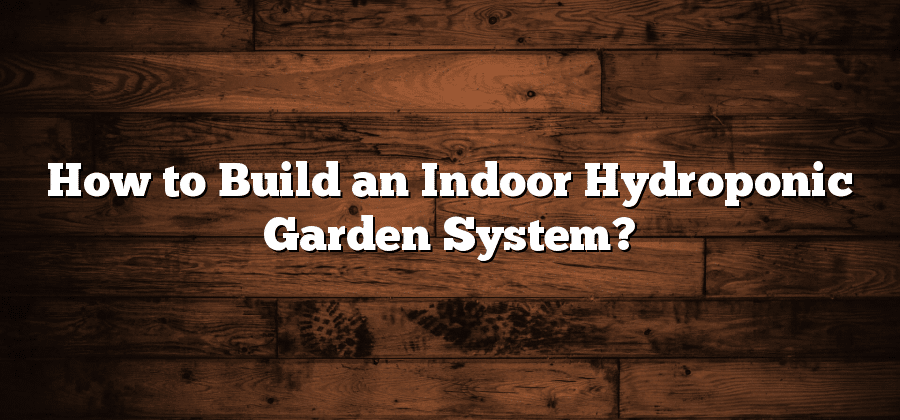Getting Started with Indoor Hydroponic Gardening
Indoor hydroponic gardening is an innovative and efficient way to grow plants without the need for soil. This method of gardening utilizes water-based nutrient solutions to provide plants with the essential nutrients they need to thrive. By eliminating the need for soil, indoor hydroponic gardening allows for better control over environmental factors such as temperature, humidity, and light, providing optimal growing conditions for plants.
To get started with indoor hydroponic gardening, first, you will need to gather the necessary equipment. This includes a hydroponic system, which can vary in size and complexity depending on your needs and space available. Additionally, you will need nutrient solutions specifically formulated for hydroponic gardening, as well as a pH testing kit to ensure the nutrient solution is maintained at optimal levels. It is also important to consider the lighting requirements of your plants, as well as the location of your indoor garden to ensure it receives adequate light throughout the day. With the right equipment and knowledge, you can embark on a successful indoor hydroponic gardening journey, enjoying the benefits of fresh and healthy produce all year round.
Choosing the Right Location for Your System
When it comes to setting up an indoor hydroponic gardening system, one of the crucial factors to consider is choosing the right location. This decision can greatly impact the success of your plants and the overall efficiency of your system. Ideally, you want a space that provides ample access to natural light or proper artificial lighting options, as well as a stable and controlled environment.
Firstly, consider the lighting conditions in the chosen space. If you have access to a room with large windows that receive plenty of direct sunlight, that could be a fantastic option for your indoor garden. Natural light not only provides the necessary spectrum of light for plant growth but also helps to minimize energy consumption. However, if natural light is limited or not available at all, you will need to invest in suitable artificial lighting options such as LED or fluorescent grow lights. These lights need to be positioned at the right height and angle to ensure optimal plant growth and avoid any shadowing effects.
Selecting the Ideal Hydroponic System for Your Needs
When it comes to selecting the ideal hydroponic system for your needs, there are several factors to consider. First and foremost, you must determine the space available for your indoor garden. If you have a limited area, vertical hydroponic systems or stacked vertical towers may be the best option for maximizing your growing space. On the other hand, if you have a spacious room or greenhouse, a large-scale ebb and flow system or a nutrient film technique (NFT) system could provide the versatility and capacity you require.
Another important aspect to consider is your level of expertise and the amount of time you are willing to invest in your hydroponic garden. For beginners or those with limited experience, a simple and automated drip irrigation system can often be the most suitable choice. These systems require minimal maintenance and are easy to set up and operate. However, if you are an experienced gardener and eager to experiment, more advanced systems like aeroponics or deep water culture (DWC) may be the perfect fit for you. These systems allow for precise control over nutrient delivery and can yield impressive results when properly managed.
In conclusion, selecting the ideal hydroponic system for your needs requires careful consideration of factors such as available space and your level of expertise. By evaluating these aspects and seeking advice from experienced hydroponic gardeners or professionals, you can ensure that you choose a system that will provide optimal results and satisfaction in your indoor gardening endeavors.
Determining the Best Lighting for Your Indoor Garden
When it comes to indoor gardening, providing the right lighting conditions for your plants is crucial. However, determining the best lighting for your indoor garden can be a complex task. There are various factors to consider, including the type of plants you are growing, their growth stage, and the specific requirements of each plant species.
One of the most common types of lighting used in indoor gardening is fluorescent lighting. This type of lighting is energy-efficient and provides a good spectrum of light. Fluorescent lights are suitable for a wide range of plants, especially leafy greens and herbs. Another option is high-intensity discharge (HID) lighting, which includes metal halide (MH) and high-pressure sodium (HPS) lights. These lights are more intense and emit a higher spectrum of light, making them suitable for flowering and fruiting plants. LED lights are also gaining popularity in indoor gardening due to their energy-saving capabilities and adjustable light spectrum. Whatever lighting system you choose, it is important to ensure that the light intensity is appropriate for your plants’ needs and that the light is distributed evenly across the entire garden area.
Understanding the Essential Nutrients for Plant Growth
There is no denying that providing essential nutrients is crucial for the growth and development of plants in indoor hydroponic systems. These nutrients play a vital role in facilitating various physiological processes, such as photosynthesis, respiration, and cell division. Without a proper understanding of these essential nutrients, your indoor garden may face stunted growth, nutrient deficiencies, or even failure. Therefore, it is imperative to have a comprehensive knowledge of the essential nutrients needed for healthy plant growth in your hydroponic garden.
The key nutrients required for plant growth can be broadly categorized into macronutrients and micronutrients. Macronutrients, including nitrogen (N), phosphorus (P), and potassium (K), are required in relatively large quantities and are primary components of plant tissue. On the other hand, micronutrients, such as iron (Fe), manganese (Mn), zinc (Zn), and copper (Cu), are essential in smaller amounts but are equally important for overall plant health. Understanding the role and optimal levels of these nutrients is crucial for maintaining plant health, promoting vigorous growth, and maximizing yield in your indoor hydroponic garden.






